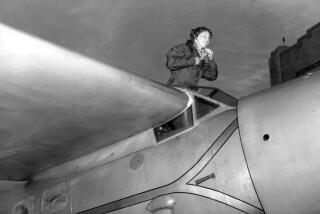Applying Math to the Earhart Mystery
- Share via
Not another harebrained theory on the search for Amelia Earhart’s plane, Caltech professor Fred Culick groaned. But the phone message was from a producer for “Nova,” the respected PBS science series, so he returned the call.
Four years later, Culick has confirmed an intriguing theory about what happened to Earhart’s Lockheed Electra twin-engine plane. According to his calculations, the plane crashed in the icy depths of the central Pacific Ocean just short of Howland Island, roughly between Hawaii and Australia. The theory hints at a tantalizing possibility: 17,000 feet underwater, in a cold storage of sorts, the Electra’s aluminum fuselage could be found intact, along with notebooks, maps and charts (human remains, though, corrode in saltwater).
Culick, with the help of graduate student Grant Swenson, provided the analysis at no charge. “It’s just solving a mystery and putting to rest all these harebrained theories,” said Culick, a professor of mechanical engineering and jet propulsion. “It’s nice to get to the truth.”
Armed with Culick’s study of Earhart’s fuel use and other new data, a deep-sea exploration company is leading one of two competing expeditions this year to try to crack one of the 20th century’s greatest mysteries: Why did Earhart’s plane vanish without a trace on July 2, 1937, in her attempt to fly around the world?
On Thursday, a Delaware-based nonprofit group plans to head to another central Pacific island, about 375 miles south of Howland Island. The International Group for Historic Aircraft Recovery is relying on satellite images showing a rust-colored shape that members hope indicate the remains of Earhart’s plane off Nikumaroro island. The spot is exactly where a former resident of Nikumaroro had said that her father once pointed out an airplane wreckage on a reef at low tide.
The international group, an archaeological aviation foundation, believes that Earhart managed to land on a coral reef and made it to the then-uninhabitated island with her navigator, Fred Noonan. The two presumably died of starvation and exposure, according to the theory. Since 1988, the group has spent $2 million on five exploratory visits to Nikumaroro, turning up no conclusive evidence.
“It just doesn’t happen like it does in Indiana Jones movies,” said Richard Gillespie, the group’s founder. “I’m trying to say, ‘Look, folks, this is archaeology. This is plodding, mechanical stuff. Don’t everyone hold your breath that we’re going to come back with Amelia Earhart’s airplane.”’
Gillespie says he is confident that the group is on the right path.
The Howland Island expedition is based on a theory developed by aviation expert Elgen M. Long, who spent more than 25 years piecing together information about Earhart’s radio transmissions and her plane’s fuel use to retrace her final flight path. Long, the co-author of “Amelia Earhart: The Mystery Solved” (Simon & Schuster, 1999), is part of a team including “Nova” and Maryland-based Nauticos Corp. The team still is raising money to finance a $5-million expedition later this year. In an 800-square-mile search area, the team plans to use sonar technology to pinpoint the location of the plane in water as deep as 20,000 feet.
Since Earhart and Noonan disappeared, and an extensive U.S. Navy search at the time failed to turn up any trace of them or their plane, their fate has been the subject of heated, complex and sometimes wild debate. Some speculate, for instance, that Earhart and Noonan landed on an island, only to be executed as U.S. spies by the Japanese.
The truth, Culick said, boils down to a simple question: How far did Earhart fly after her last radio transmission? Earhart, 39, took off from New Guinea and headed toward Howland Island, where she was to meet a U.S. Coast Guard cutter for refueling. About 50 miles west of Howland Island, she radioed the cutter that she had about half an hour’s worth of fuel left.
Culick started by tracking down Lockheed performance reports on her aircraft and engine, along with data on how the plane performed in wind tunnel tests. He factored in an estimate of headwinds she faced. Then he calculated the approximate spot her plane would have run out of fuel and plunged into the ocean.
“Within a reasonable error,” he said, “I think we understand pretty well what happened.”
Earhart’s niece, Amy Kleppner, agrees that her aunt’s plane is probably in the waters near Howland Island. But she never hooked into the mystery.
“Not every mystery in the world is worth the investment of millions of dollars,” said Kleppner, a retired Maryland schoolteacher who was 5 when her aunt disappeared. “I think her legacy is alive and well and probably always will be, whether or not the last line of a children’s story on her life says, ‘And her wreckage was found in such and such a place, or it was a mystery that was never solved.”’






